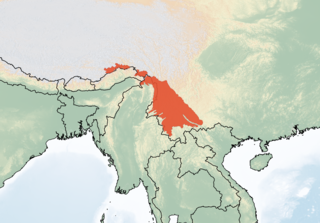
The Arvicolinae are a subfamily of rodents that includes the voles, lemmings, and muskrats. They are most closely related to the other subfamilies in the Cricetidae. Some authorities place the subfamily Arvicolinae in the family Muridae along with all other members of the superfamily Muroidea. Some refer to the subfamily as the Microtinae or rank the taxon as a full family, the Arvicolidae.
The Chinese dormouse or Sichuan dormouse is a species of dormouse found in subalpine mixed forests in northern Sichuan, China, where it is known from Jiuzhaigou and Wanglang Nature Reserves. It is known only from two captured female specimens taken in the Wanglang Natural Reserve, and was first described by Wang Youzhi in 1985 and relisted by Corbet and Hill under a new genus as Chaetocauda sichuanensis. It is currently the only member of the genus Chaetocauda. The two specimens had head and body lengths of 90mm and 91mm and tail lengths of 92mm and 102mm, respectively. They weighed 24.5 and 36.0 g. It is nocturnal and arboreal, nesting in trees around 3 metres above the ground, and was found above an altitude of 2500m above sea level. It is classified as endangered by the IUCN as of the 2004 Red List due to its small, isolated habitat.

The reed vole is a species of vole. It is found in northern and central Eurasia, including northern China and the Korean Peninsula. This species is somewhat larger and longer-tailed than most other voles.
Pratt's vole is a species of rodent in the family Cricetidae. It is endemic to Mount Emei, Sichuan, China. It was named in 1891 for Antwerp Edgar Pratt.
The Southwest China vole is a species of rodent in the family Cricetidae. It is found only in Yunnan and Sichuan, China. It occurs in Cangshan Erhai Nature Reserve.
The Ganzu vole, Eva's red-backed vole, Eva's vole, Gansu vole, or Taozhou vole is a species of rodent in the family Cricetidae. It is found in mountain forests in China. The IUCN has assessed it as being of "least concern".
The Kolan vole, Inez's red-backed vole or Inez's vole is a species of rodent in the family Cricetidae. It is found only in China. Two subspecies have been recognized, Caryomys inez inez from the northern part of its range and Caryomys inez nux from the southern part.
The Chaotung vole is a species of rodent in the family Cricetidae. It is found only in Yunnan, Sichuan, and Guizhou, China.
The Shansei vole is a species of rodent in the family Cricetidae. It is found only in north-central China where its habitat is forests.
The Chinese scrub vole, or Irene's mountain vole, is a species of rodent in the family Cricetidae. It is endemic to mountainous parts of southern China and is very similar to the Sikkim mountain vole in appearance. The International Union for Conservation of Nature has assessed its conservation status as being of "least concern".

Blyth's vole is a species of rodent in the family Cricetidae. It was previously the only species in the genus Phaiomys, but was moved to Neodon in 2016. It is found in mountainous regions in northern India, Nepal and China. It is a burrowing rodent and lives in small colonies. It has a wide distribution and faces no particular threats so the International Union for Conservation of Nature has assessed its conservation status as being of "least concern".
Maximowicz's vole is a species of rodent in the family Cricetidae. It is found in northeastern China, Mongolia, and eastern Russia.
The Sikkim mountain vole is a species of rodent in the family Cricetidae. It is found in Bhutan, India, Nepal and China.
The large white-bellied rat, also known as the Sichuan niviventer, is a species of rodent in the family Muridae. It is found only in southwestern China. It occurs in Jiuzhaigou National Nature Reserve of Sichuan, southwestern Sichuan, northwestern Yunnan, and the Ailao Mountains of Yunnan.
The Duke of Bedford's vole is a species of rodent in the family Cricetidae. After the Liangshan vole was removed from this genus, the Duke of Bedford's vole became the only member of the genus Proedromys. It is found only in mountainous parts of central China. It is a rare species and the International Union for Conservation of Nature has assessed its conservation status as being "vulnerable".

Clarke's vole is a species of rodent in the family Cricetidae. It is found only in China.
Volemys is a small genus of rodents in the family Cricetidae. It contains the following species, both of which are endemic to China:
Marie's vole is a species of rodent in the family Cricetidae. It is found only in China. Volemys musseri is one of two species in the genus Volemys along with the Szechuan vole.

Glover's pika is a species of mammal in the family Ochotonidae. It was first described in 1922, by Michael Rogers Oldfield Thomas. The summer dorsal pelage is grayish rufous, grayish brown, or tea brown in colour. The winter pelage is similar to the summer pelage, but is lighter in tone. Endemic to China, it is found in high altitudes of northeastern Tibet, southwestern Qinghai, western Sichuan, and northwestern Yunnan. It is a generalist herbivore, and is known to construct haypiles. It is rated as a species of least concern by the International Union for Conservation of Nature. It is also regionally red listed as least concern in China.
Schidlovsky's vole is a species of rodent in the family Cricetidae. It is normally found in northwestern Armenia, and was long considered a subspecies of the social vole until relisted as a species by Golenishchev in 2002.





